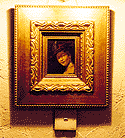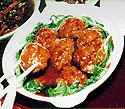A small group of foreigners holes up in the
diplomatic quarter of Beijing for almost three months. Their staple
diet is donkey meat, washed down with champagne looted from an expatriate
delicatessen called Imbeck's Store. Sound like anyone you know? Plus
a change, eh: these events occurred just over 100 years ago during the
Boxer Rebellion when soldiers of the Society of Harmonious Fists laid
siege to the foreign legation quarter with the tacit consent of the
Empress Dowager Cixi. Imbeck's Store was located just west of one of
contemporary Beijing's most pleasant streets Zhengyi Lu (Justice Street)
a quiet tree-lined avenue that runs south from Chang An Boulevard, opposite
the Beijing Hotel. The diplomatic geography of Beijing has changed since
the Boxer Rebellion. Modern-day embassies get Sanlitun while most of
the buildings in the old legation quarter belong to Chinese government
ministries. The Beijing Communist Party headquarters and the Ministry
of Public Security both border Zhengyi Lu. Until recently so did an
Italian restaurant called Renaissance.

Renaissance was started by Beijing artist Kang
De. Although he had never been to Italy and didn't particularly like
Italian food, he liked Italian Renaissance paintings, hence the name
and choice of cuisine. The concept apparently didn't work and a year
ago Renaissance changed its name and switched to a cuisine that is in
Beijing at least considered more sophisticated than foreign noodles
could hope to be. I speak of course of Shanghainese food.

The sign over the front door that still says
Renaissance and the teapots and plates with this name in brown lettering
might lead you to suspect that the restaurant is still called Renaissance,
but it has in fact been renamed Hucai Guan which simply means Shanghai
Cuisine. The decor hasn't changed however, and that is a big part of
the charm. Facing the front door is a Western-style pine bar counter.
Several rustic wood-hewn shelves bear an array of bottles, the price
of each drink marked on a pale blue price tag like they use behind the
counters in Chinese state-owned department stores. The main room of
the restaurant has rough white-washed walls and railway-sleeper sized
wooden ceiling beams. The chairs are made of heavy carved wood and the
tablecloths are crimson. Oil paintings hang on every wall, pictures
of boats on beaches and pastoral scenes like you might find in somebody's
seaside cottage. This large collection of kitsch paintings has a surprisingly
pleasing effect. Each one has a different heavy wooden frame and the
subtle lighting ensures that the room doesn't feel like the Art section
of a department store. In fact, a rowdy party in the karaoke room next
door and the lone European man looking up from his dinner at us as we
sit down make the place feel more like the set of a surreal spy movie.

The old Shanghai hand of our party orders. For
starters we have preserved duck eggs with cold tofu, hairy soya beans,
peanuts, and a whole cold-baked pigeon. The bird is finicky to eat lots
of bones but the delicate flavor is worth the effort of sucking and
chewing. But nothing really impresses us until the main courses arrive.
Tofu knots with braised meat looks a bit strange but is a superb combination
of sweetish meaty tastes and soft textures. The subtle flavors and tenderness
of braised Mandarin fish makes one of our group exclaim: I'm a fishatarian.
Which is what you should be at Renaissance because while the meat dishes
are all average, the seafood is excellent. Sauteed shrimps and braised
eels are our favorites. The flavors are clean and fresh, and the laowai
are happy because there are no bones. Crispy-skin tofu is also good:
it is made with fragrant mushrooms that contrast nicely with the mild
flavor of the bean curd. The fresh vegetables are tasty too: we have
braised eggplant and two Southern vegetables that many Beijingers don't
know, caijie (mustard greens) and penghao (kale). We have both of these
in a delicious garlic sauce.

The waiters wearing clean but badly-fitting
suits look like trainees just arrived from the countryside which they
may in fact be: the service is lousy. But Renaissance or whatever you
choose to call it is a restaurant I shall visit again soon. It's a great
place to take visitors from out of town who want good Chinese food in
an unusual setting. They have an English menu. Expect to spend ´60-100
per person for good Shanghai cuisine that citizens of the Paris of the
East would be happy to find in the Northern Capital.







